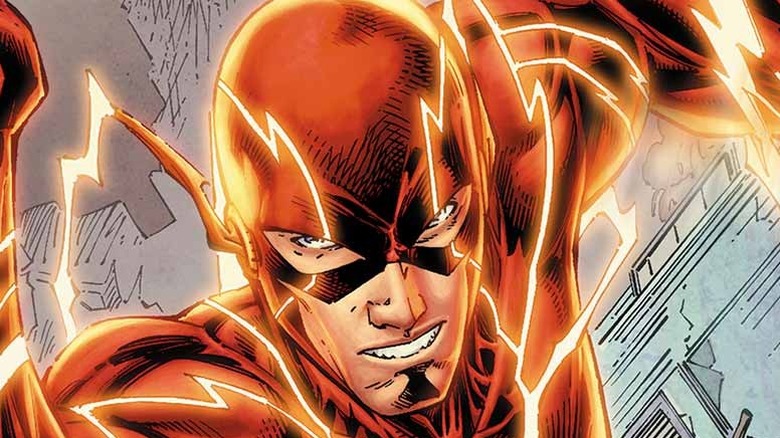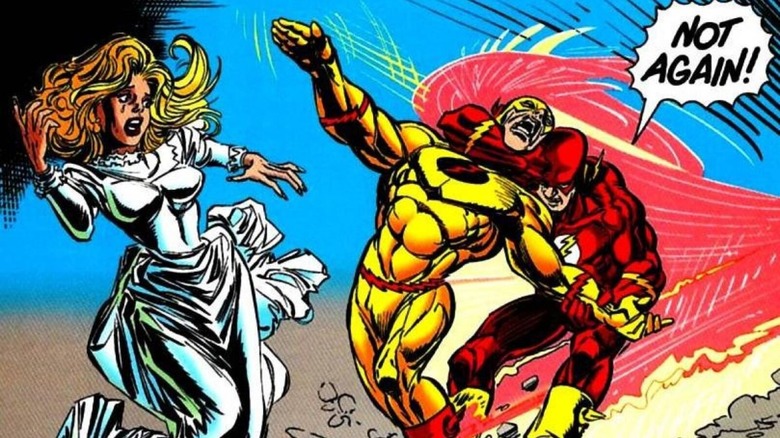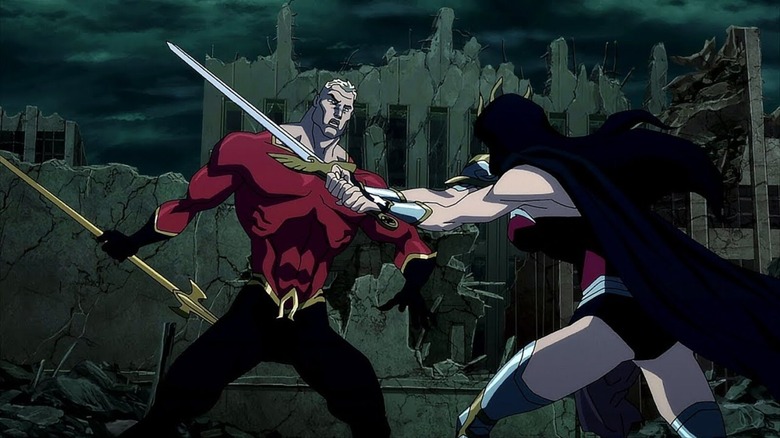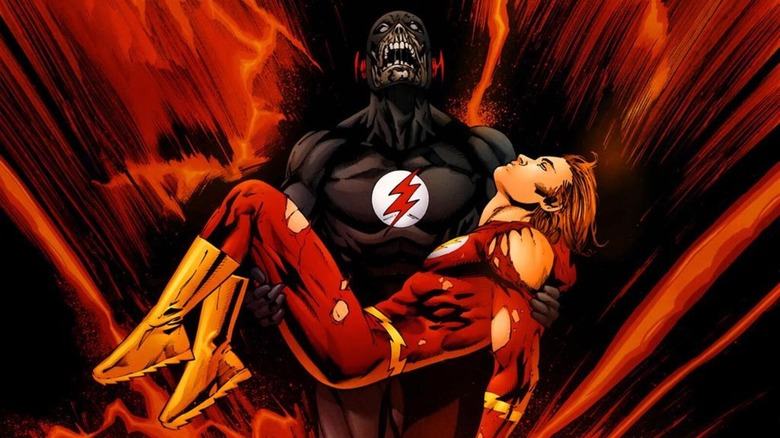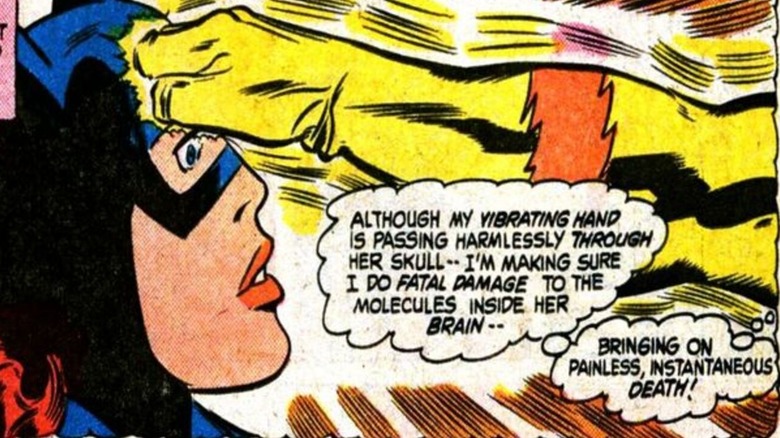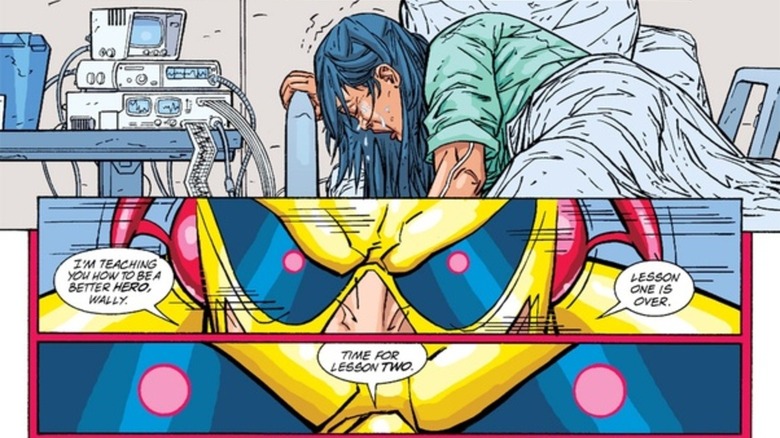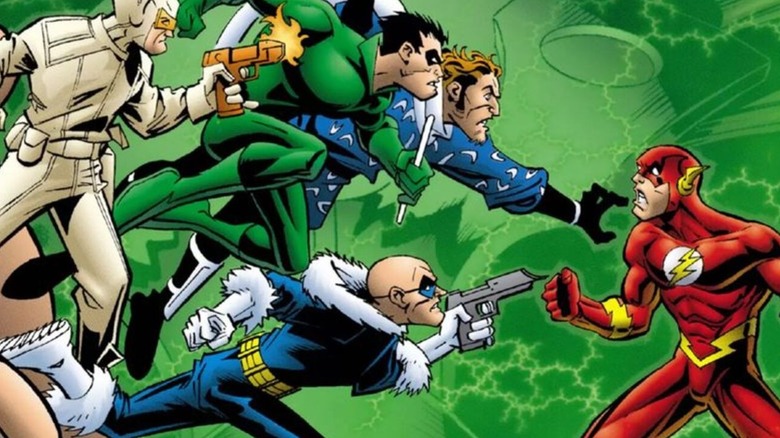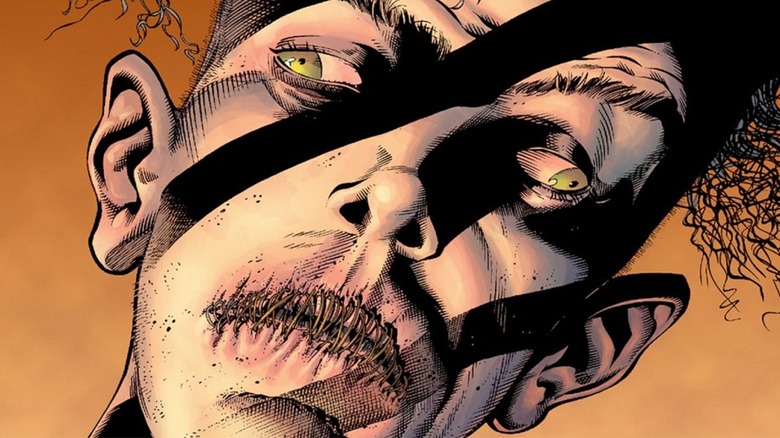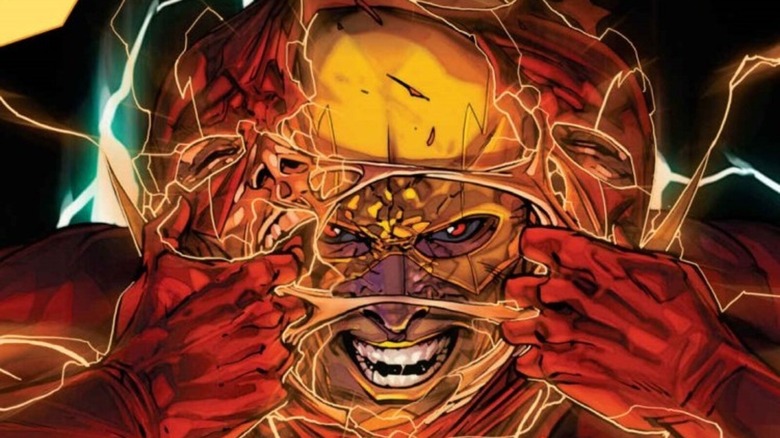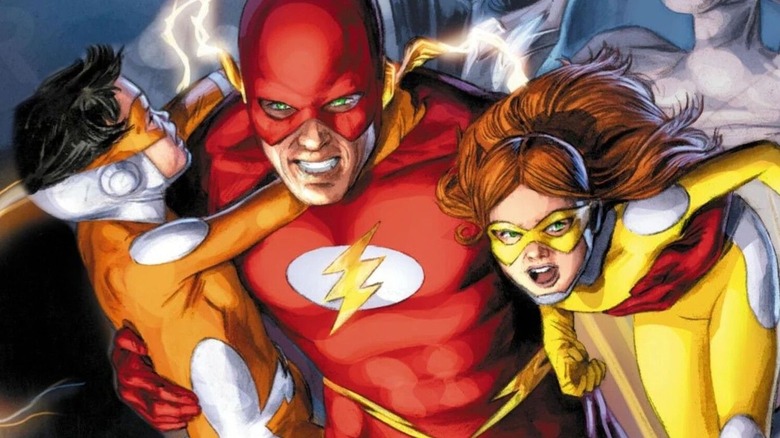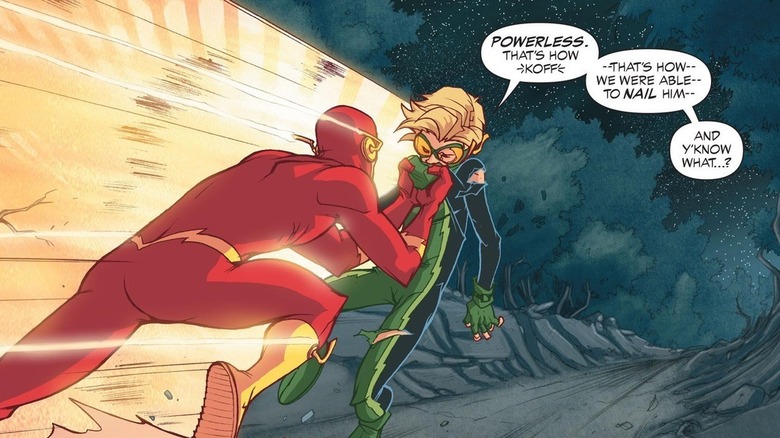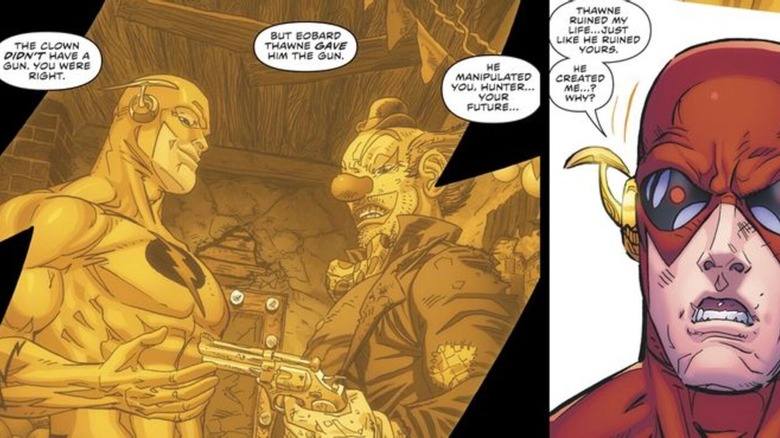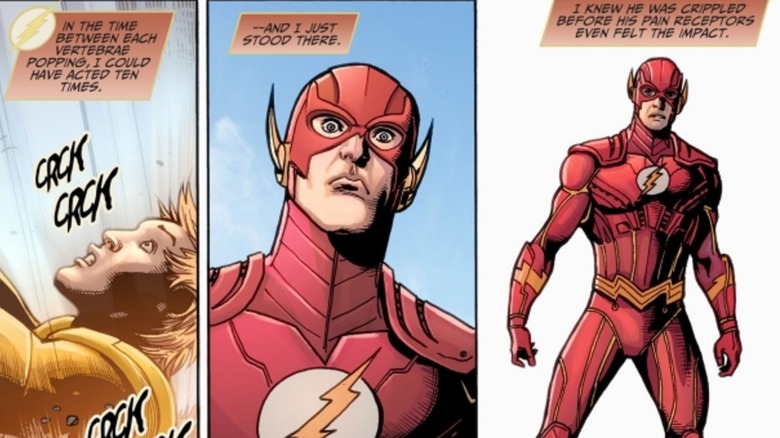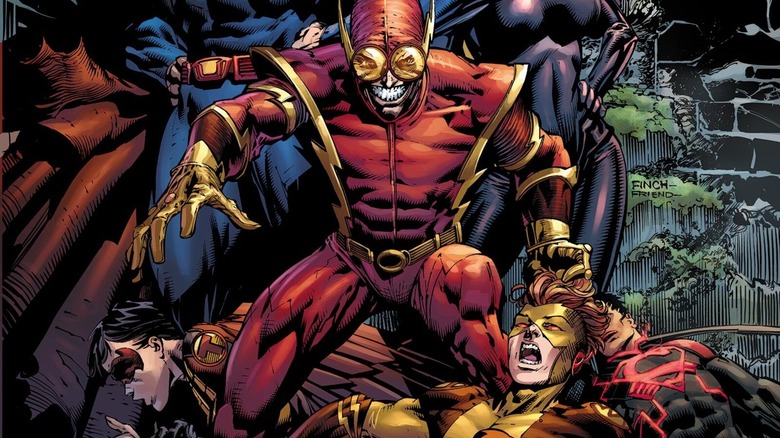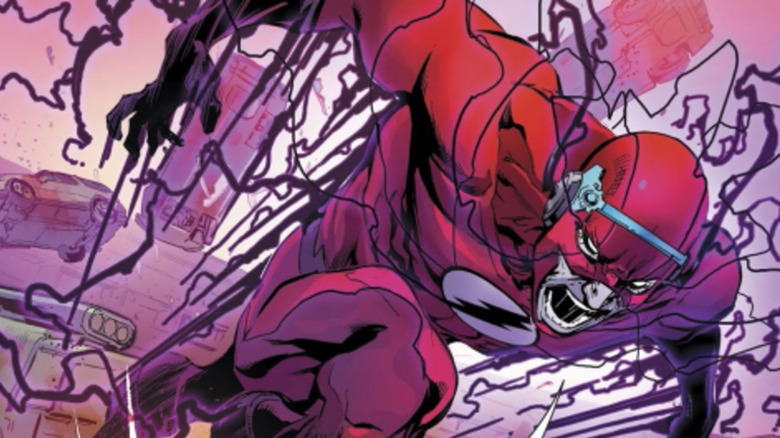The Dark History Of The Flash
In the pantheon of DC Comics' mightiest superheroes, the Flash is the number-one speed-based hero. But limiting him to this ability does a grave injustice to the character's evolution. Not only is the Flash fast, he can phase through solid objects, travel through time, pack a punch with infinite mass, access the otherworldly "Speed Force," and much more. The Flash also does not work alone, but is part of an entire family of speedsters who belong to different eras of the DC multiverse, including Barry Allen, Wally West, Jay Garrick, Jesse Quick, and many more.
Naturally, a hero with such a complicated power set, extensive history, and large family of supporting characters has witnessed a wide range of highs and lows over the years. And that's not even getting into the Flash's diverse and fascinating gallery of villains — they've been the source of much grief for both the Flash family and the world in general. These are the darkest moments in the Flash's history.
The Flash kills his worst enemy
The "no killing" rule is an important part of superhero mythology. Most superheroes make a vow never to use their powers to take a life, no matter what the provocation. This helps separate the heroes from the anti-heroes, who have no problem taking lives for what they perceive to be the greater good.
The Flash has always been a mortally upright hero who never kills to solve his problems ... except that one time. In the 1983 story arc, "The Trial of the Flash," the Scarlet Speedster finally takes the ultimate step against his arch-nemesis, the Reverse-Flash. The supervillain has long been a thorn in the side of Barry Allen: By this point, Reverse-Flash has already killed Barry's wife, Iris, and intends to kill Fiona Webb, Barry's new fiancé.
In the fight to save Fiona, Barry snaps the Reverse-Flash's neck. Horrified by what he has done, Barry turns himself over to the police. He then stands trial for his crime as his life falls apart around him. Flash's Justice League membership is almost revoked, his marriage plans are shattered, and the rest of his rogues' gallery keeps attempting to take him down. All in all, this is one of the darkest periods in Barry's life, even if the storyline ends on a positive note.
The Flash brings about the apocalypse
"Flashpoint" is definitely the Flash's most well-known storyline. The 2011 comic arc is so popular that it's been adapted for the CW "Flash" TV series, a 2013 animated movie entitled "Justice League: The Flashpoint Paradox," and will form the basis of the upcoming DCEU "Flash" movie. What's "Flashpoint" about? Well, it all comes down to the Flash unwittingly bringing about the demise of the world as we know it.
The story starts with Barry Allen waking up in a world where his father was never released from prison. The Justice League doesn't exist. Superman is missing. Batman is a murderous vigilante. The armies of Aquaman and Wonder Woman are locked in a fierce battle to rule the Earth. It is, in short, a rough place.
As he witnesses the world in turmoil around him, Barry comes to realize that he caused this state of events when he travelled back in time to prevent the murder of his mother. It is then up to Barry to reset the timeline back to the way things were, even though it tears him apart inside to do so. His mother has to die, lest the world fall into chaos, and Barry can do nothing to change this.
The Grim Reaper of the Speed Force
Since the Flash's main ability is super-speed, there are very few characters in DC Comics who can keep up with him, let alone beat him. But there is one entity that even the characters with access to the Speed Force cannot outrun: The fearsome being known as Black Flash.
In DC lore, the Black Flash acts as the Grim Reaper of the Speed Force, tasked with reaching out to speedsters in the moments before their deaths and drawing them back into the Force. As a result, several speedsters including Barry Allen, Wally West, and Johnny Quick have had encounters with the Black Flash, and few have lived to tell the tale.
What makes the villain particularly terrifying is that his origins are shrouded in mystery. Some comics theorize that Death of the Endless, the Black Racer, Nekron, and Black Flash are all different personifications of a singular Death. Others hint that Barry Allen turned into Black Flash after his death, and that the current Black Flash is a time-displaced version of him. What is clear is that he's terrifying, implacable, and enormously powerful.
Targeting the Flash's loved ones
There is an unwritten rule that a superhero's loved ones are generally going to be safe from harm, though they'll often be in peril. But the Flash's arch-nemesis, the Reverse-Flash, has always disregarded this rule. In fact, he takes a vicious pleasure in hurting Barry Allen's loved ones.
The Reverse-Flash, whose actual name is Eobard Thawne, debuted in the comics in 1963. Though his origins and relationship with the Flash have changed over time, he is from the future in most stories. This means he already knows the full history of the Flash's secret identity and the people he loves. In one version of events, it is Reverse-Flash who goes back in time to kill Barry's mother Nora when Barry is a child.
Even more devastating is the comic in which Reverse-Flash falls in love with Iris Allen, Barry's wife. In 1983's "The Flash" #283, Thawne offers his hand in marriage to Iris, who forcefully rejects the offer. In retaliation, Thawne murders Iris by vibrating his hand inside her skull, then frames another man for the crime.
Hunter Zolomon hits home
The Reverse-Flash is generally considered one of the worst villains in comics. He is not often motivated by a desire for personal gain — instead, he acts out of a desire to punish the Flash as much as possible. And if you thought Thawne was bad, get ready to meet Hunter Zolomon, who manages to be an even more sadistic Reverse-Flash.
While Thawne mostly fights Barry Allen, by the time Zolomon arrives, Wally West has taken up the mantle of the Flash. In the 2003 "Flash" storyline "Blitz," Wally and his wife Linda are preparing for the arrival of their twins. This does not sit well with Zolomon, who has decided he needs to mold Wally into a better superhero by subjecting him to great personal misery.
To that end, "The Flash #192 through 200 sees Zolomon go to war against Wally and his allies. Zolomon has the ability to displace himself through time at will, something the speedsters are helpless against. The Reverse-Flash strikes the biggest blow against Wally when he snaps his fingers, creating a supersonic shock wave that results in Linda miscarrying the twins.
The Rogues go truly bad
The Flash has one of the best collections of villains in comics. One reason they're not as notorious as, say, Batman's villains, might be because these rogues usually operate within a strict code of honor. Most times, the Flash's villains believe in doing as little damage as possible to civilians or public property while going about their business. They're bad guys, but they're not bad guys, you know?
But there is one chapter in the Flash's history during which the rogues embrace a disturbing departure from their code. In the 1995 crossover event "Underworld Unleashed," the Flash discovers Captain Cold, Heat Wave, Mirror Master, Weather Wizard, and Captain Boomerang operating in a much more cruel manner. The villains are killing civilians and destroying the city with sadistic glee, reveling in creating chaos for its own sake.
It is eventually revealed that the five supervillains have unwittingly entered into a pact with Nekron, a demon lord, and have been transformed into his demonic minions. Fortunately, the Flash is able to find a way to break the terms of the deal, and the bad guys get their souls back. Many of them are so shaken by the experience that they swear off crime for a while — the Weather-Wizard even gives up supervillainy altogether so he never has to visit Hell again.
The Flash takes on Murmur
While Flash's usual coterie of supervillains tend to conduct themselves with a strict code of honor, he does face a few truly terrifying bad guys. One of them could even give Batman a few sleepless nights. His name is Michael Amar, better known as Murmur, and he's a disturbing serial killer.
Amar starts out as a surgeon at the top of his field who enjoys the love and respect of his colleagues and patients. But unbeknownst to them, Amar endures psychotic episodes that make him hear voices. To silence them, Amar goes on a killing spree as Murmur. His mental problems continue to worsen, and eventually, he takes the ultimate step to keep himself from revealing his secrets. Putting his surgeon skills to horrifying use, Amar cuts out his own tongue and sews his mouth permanently shut. He is, without question, one of the scariest villains the Flash has ever faced.
The Flash's personal life takes a beating
The Flash has one of the most turbulent personal lives in comics. This is often because the Reverse-Flash insists on using the Flash's loved ones against him. Most times, the villain's plans are foiled and things go back to normal. But in one instance, the toll taken is severe.
In the 2017 "Flash" arc "Running Scared," Reverse-Flash ups the ante in his personal war against Barry Allen. He starts things off with a brutal beatdown of Wally West, takes great glee in taunting Barry with visions of apocalyptic futures, and reveals his secret identity to the love of Barry's life, Iris.
It is this last act that delivers a particularly punishing blow against Barry: Even after he manages to take down the Reverse-Flash, Iris still feels betrayed. Barry is left broken-hearted and alone in his apartment after Iris leaves him. He is riddled with guilt over how often he has been forced to put his life as the Flash over Iris and everyone else he cares about — exactly the sort of state Reverse-Flash sought to mire him in.
Barry Allen turns against Wally West
In comics, it's a very rare thing to replace a superhero with a new character, and have fans love the replacement as much as the original. DC Comics pulled off this tough feat with Wally West, who takes up the mantle of the Flash from Barry Allen. He became an instant hit with readers.
Wally has always admired Barry as his ultimate inspiration, and hopes to live up to the example he's set. Barry, in turn, is supportive of Wally taking over his duties ... most of the time. There is a moment, during the events of the 2016 "Flash" arc "Flash War," when that bond is stretched to breaking point for the most heartbreaking of reasons.
The trouble starts when Wally wants to tap into the Speed Force in order to save his children. Barry refuses to let him do so, out of fear of Wally's actions causing a disruption in the timeline, as has happened to Barry. Naturally, Wally is too desperate to listen to reason. Barry goes so far as to threaten Wally with a fate worse than death if he doesn't obey him: He promises to make sure Wally never runs again if he dares follow through with his plan. It's a rift between the two neither character, nor the fans, can forget.
Wally West exacts dark justice on Inertia
Most of the time, superheroes use their powers in a defensive manner. Even when fighting villains, they generally try to minimize unintentional casualties — Superman pulls most of his punches, for example, lest every bad guy's head end up smashed to bits. But even a hero's patience can be exhausted. And that is when we see the terrible, most chilling extent of their abilities.
There are many mind-boggling ways in which the Flash can use his super-speed to deal with enemies. But his fights usually end with the villain of the day tied up or in prison. Not so with Inertia, a time-displaced psychotic clone of the speedster Bart Allen. In the 2007 comic "All Flash" #1, Inertia plots to take down Bart once and for all — and is actually successful in doing so.
Inertia's victory is short-lived. An enraged Wally decides the villainous speedster needs to be punished for his crime to (what he deems to be) an appropriate degree. To that end, Wally uses his powers to slow down Inertia's body to the point that the former speedster becomes a living statue. Wally then places Inertia in the Flash Museum, facing a statue of Bart Allen. There, Wally details, he'll be "forced to stare, with eyes that take a hundred years to blink ... at the ghost of a man he could never be."
How the new Reverse-Flash was created
By now, it should be amply clear just how much Eobard Thawne hates Barry Allen. But Thawne's hatred is not limited to the Flash alone. Not only has Thawne killed his own parents and undone his brother's existence, he's also directly responsible for the creation of the next Reverse-Flash, Hunter Zolomon.
In 2019's "The Flash" #81, Hunter discovers that Thawne is the one who had handed a gun to Lyle Corley. Before becoming Reverse-Flash, Hunter had been an FBI profiler working on the case of a serial killer who dressed as a clown. That clown was Corley. Hunter managed to track down Corley and demanded he give himself up.
The criminal profile that Hunter had created for Corley indicated that the clown would not be armed. But Corley did indeed have a gun, given to him by Thawne, that he used to injure Hunter and kill his father-in-law. This incident resulted in Hunter's downward spiral, which led him to becoming Reverse-Flash.
The Flash who turned bad
The DC mythos is made up of many distinct universes. Many of these universes feature their own versions of DC superheroes, but not all versions are as heroic as their mainstream counterparts. Case in point: Barry Allen from the universe captured in the "Injustice: Gods Among Us" comic series is not the nicest dude.
When the Superman of this universe decides tyranny is the only way to ensure permanent peace, Flash joins the Man of Steel in his efforts. Over time, however, Barry comes to realize how ruthless Superman has become. He defects over to Batman's side and works to bring down Superman's regime.
Although this version of Barry does eventually turn good again, there is a time when he does all manner of morally dubious things under Superman's orders. Most prominently, he forces Aquaman to bow down before the regime by holding his entire kingdom hostage. It is clear, at least, that Barry initially genuinely believes that Superman's dictatorship is a good thing for the world, and later comes to be ashamed of his actions. But still — it's really something to see the Flash work on behalf of a ruthless despot.
The Flash who was born evil
The DC multiverse does not only contain good versions of the Flash and versions who went bad due to misguided principles. Some versions of the Scarlet Speedster are simply born bad, through and through. They've been a problem for not just their own universes, but the entire multiverse.
Case in point: Johnny Quick, who is the Flash from Earth 3. In this world, the Justice League has been replaced by the Crime Syndicate of America, a group of metahumans who only want to live a life of selfish debauchery. Johnny Quick takes great pleasure in spreading destruction, personally slaughtering untold thousands on his own home world before jumping into mainstream DC continuity, along with the rest of the Syndicate.
The worst versions of Flash, however, are those spawned from the dreaded Dark Multiverse. This realm is described as a "shadow" of the true multiverse, spawned by every negative thought and action ever conceived. The most prominent Flash of the Dark Multiverse is actually Bruce Wayne, the Batman of Earth-52, who calls himself the Red Death. This version of the Scarlet Speedster, first seen as a lieutenant of The Batman Who Laughs, is a fusion of Bruce and Barry Allen created after Bruce planned a way to rob Barry of his speed. What's worse, Barry's consciousness is still alive somewhere within the Red Death, constantly pleading for Bruce to put an end to the carnage he commits.
The dark side of the Speed Force
What separates the Flash and his allies from other speedsters is that their speed is not an innate ability, but rather a result of their connection to something called the Speed Force. This source of power is an energy field that can connect a speedster to some of the most primordial forces in the Multiverse, granting virtually limitless power.
But not all aspects of the Speed Force are benign. Just as the Speed Force gifts many things, it also demands something in return. Enter the Negative Speed Force, described as an extra-dimensional field of negative energy that consumes the regular Speed Force like a disease. What's more, it can consume any speedster who comes into contact with it.
This version of the Speed Force is created by Eobard Thawne, the Reverse-Flash. Thawne specifically designs the Negative Speed Force to infect other speedsters, and, by extension, the ones they love. This form of infection can be very painful, as both the negative and positive versions of the Speed Force battle to cancel each other out within the speedster's body.
